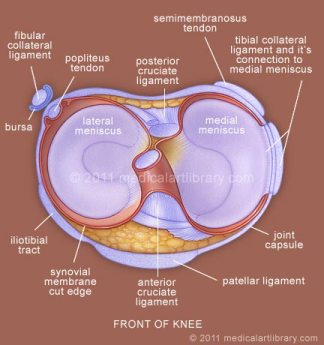Lateral meniscus
Introduction[edit | edit source]
The word menisci are derived from the Greek work meniskos, which means "crescent"[1].At knee joint the menisci plays a major role in congurency of the joint. Menisci forms the concavity in which the femoral condyles sits. Menisci rests between the thigh bone femur and the tibia and there are two knee joint ligaments. They are a type of cartilage in the joint. The rubbery texture of the menisci is due to their fibrocartilagenous structure. Their shape is maintained by the collagens within them. One meniscus is on the inner side of your knee--the medial meniscus. The other meniscus is on the outer side of your knee--the lateral meniscus.
Anatomy and attachment[edit | edit source]
The lateral meniscus is almost circular and covers a larger portion of the tibial articular surface than the medial meniscus. The lateral meniscus is consistent in width throughout its course. The anterior horn of the lateral meniscus blends into the attachment of the anterior cruciate ligament, whereas the posterior horn attaches just behind the intercondylar eminence, often blending into the posterior aspect of the ACL. There is no attachment of the lateral meniscus to the LCL. Its peripheral attachment is interrupted posterior to where the popliteal tendon passes. The capsular components attach the lateral meniscus to the tibia less firmly than the medial meniscus. The lateral meniscus is more mobile than the
medial meniscus, and has a range of movement that may be as great as 10 mm (0.4 in) in an anteroposterior direction. This mobility is explained by the close proximity of the attachments of the anterior and posterior horns and the lack of attachment to the capsular ligament posterolaterally. The firm attachment of the arcuate ligament to the lateral meniscus and the attachment of the popliteus muscle to both the arcuate
ligament and meniscus ensure the dynamic retraction of the posterior segment of the meniscus during internal rotation of the tibia on the femur as the knee begins to flex from its fully extended position.
VASCULAR SUPPLY:
The vascular supply of the menisci originates predominately from the inferior and superior lateral and medial genicular arteries. During the first year of life the meniscus contains blood vessels throughout its body but when the weight bearing starts the vascularity and the circulatory network diminish and only 25-33% area remain vascular by the capillaries of the capsule and synovial membrane[2]. The vascularity diminishes so much that in 4th decade of life only the periphery is vascular whereas the center of the menisci is avascular. The center portion is completely dependent upon the synovial fluid diffusion for nutrition [3]. The central avascular portion of menisci either does not heal completely or heal at all after injury[2].
NERVE SUPPLY:
The horns of the menisci and the peripheral vascularized portion of the meniscal bodies are well innervated with free nerve endings (nociceptors) and three different mechanoreceptors (Ruffini corpuscles, pacinian corpuscles, and Golgi tendon organs)[2][4][5]
Nutrition and innervation[edit | edit source]
Role[edit | edit source]
Injury[edit | edit source]
Special test[edit | edit source]
References[edit | edit source]
- ↑ μηνίσκος, "small moon", is diminutive of μήνη, "moon", from the root ma-, "measure", which reflects the fact the time was measured according to the phases of the moon. The word was also used for curved things in general, such as a necklace or a line of battle. (Lexicon of Orthopaedic Etymology, p 199)
- ↑ 2.0 2.1 2.2 Gray JC: Neural and vascular anatomy of the menisci of the human knee. J Orthop Sports Phys Ther 29:23–30, 1999.
- ↑ McCarty EC, Marx RG, DeHaven KE: Meniscus repair: Considerations in treatment and update of clinical results. Clin Orthop 402:122–134, 2002.
- ↑ Zimny ML, Albright DJ, Dabezies E: Mechanoreceptors in the human medial meniscus. Acta Anat (Basel) 133:35–40, 1988.
- ↑ Mine T, Kimura M, Sakka A, et al.: Innervation of nociceptors in the menisci of the knee joint: An immunohistochemical study. Arch Orthop Trauma Surg 120:201–204, 2000.







